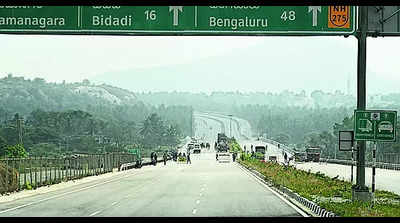- News
- City News
- bengaluru News
- From 100 to 31, fatalities on Mysuru expressway decline
Trending
From 100 to 31, fatalities on Mysuru expressway decline
Reckless driving, advanced traffic surveillance, improved lane discipline, and stringent enforcement measures have successfully decreased fatalities on the Bengaluru-Mysuru highway. The number of deaths reduced significantly from 100 to 31 in the first five months of this year.

Awareness, enforcement of discipline and installing of surveillance cameras have brought down accident counts
The first five months (till May) this year saw only 31 deaths as against a whopping 100 fatalities recorded during the corresponding period in 2023.The highway, which witnessed the movement of vehicles from Jan last year, was formally inaugurated three months later.
By May last year, the highway occupied the centre stage of discussions for the wrong reasons, the most important being serious accidents. Crashes were primarily caused by speeding, road engineering lapses, lack of lane discipline and driving on the wrong side of the road.
That was when cops initiated some corrective measures. The results started showing up: Only three persons died in road accidents on the highway this May as against 25 deaths reported during the same month last year. “When the highway was opened, motorists literally treated it as a freeway with no speed restrictions. Adding to the problem was the local motorists who would drive in the opposite direction of the traffic to reach their homes or farms quickly. There have been instances of motorists losing control and jumping lanes before crashing,” a police source pointed out.
Additional director general of police (ADGP) and commissioner for road safety Alok Kumar said continuous awareness by police and social media amplification of the ill effects of speeding changed the perception of those hitting the highway. Also, there are more than 40 automated number plate recognition (ANPR) cameras fitted at 12 points, focusing on different directions. Also, cops have prohibited two-wheelers and three-wheelers from taking the highway. In addition, slow-moving heavy vehicles including trucks are directed to move only on the extreme left lane, Kumar said.
“These cameras will identify speeding, talking on mobile while driving, not wearing seat belts and not following lane discipline. Till now, we have been identifying the violators but not booking cases against them. From July 1 this, we will start booking cases and send fine challans to their homes,” Kumar said.
He said police officers would calculate the speed of the vehicles on an ‘access control’ basis. “Some commuters know the spots where cameras are fitted. They slow down near them and press the accelerator then. Now, we will calculate the time taken by the vehicles for travelling between two cameras and they will show the speed at which the vehicle has travelled,” he said.
End of Article
FOLLOW US ON SOCIAL MEDIA










